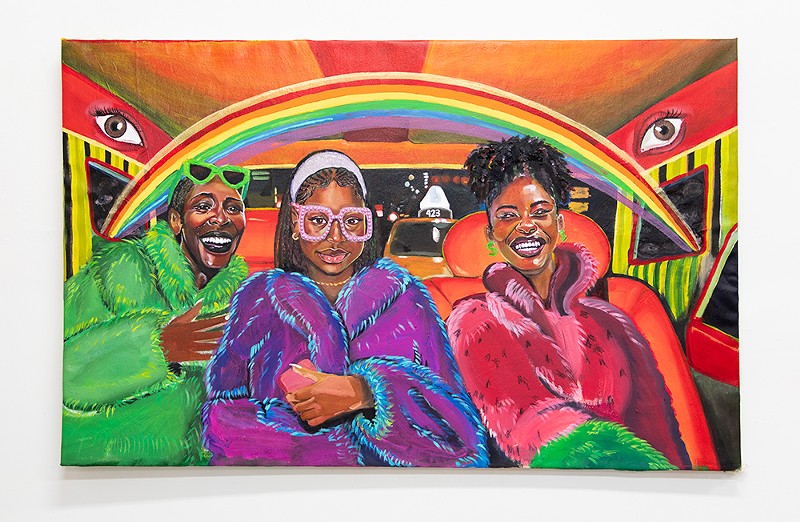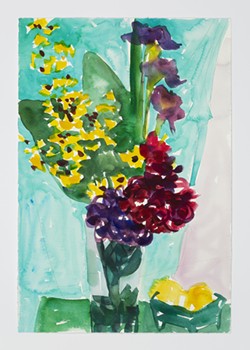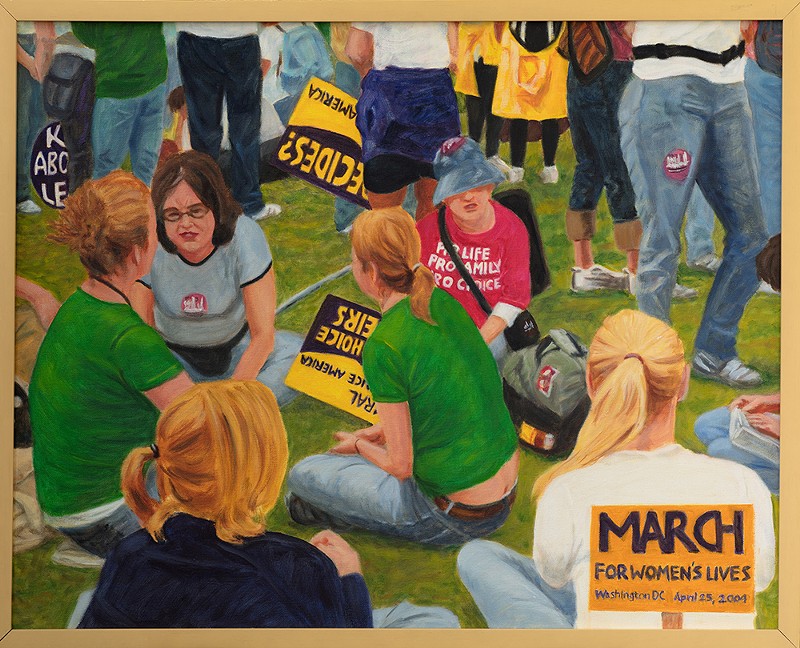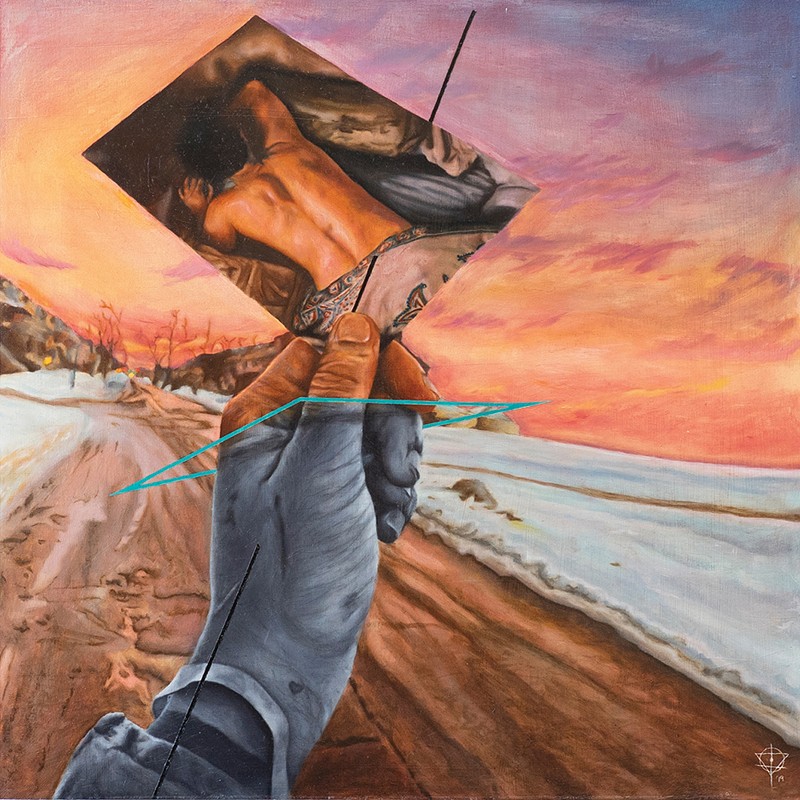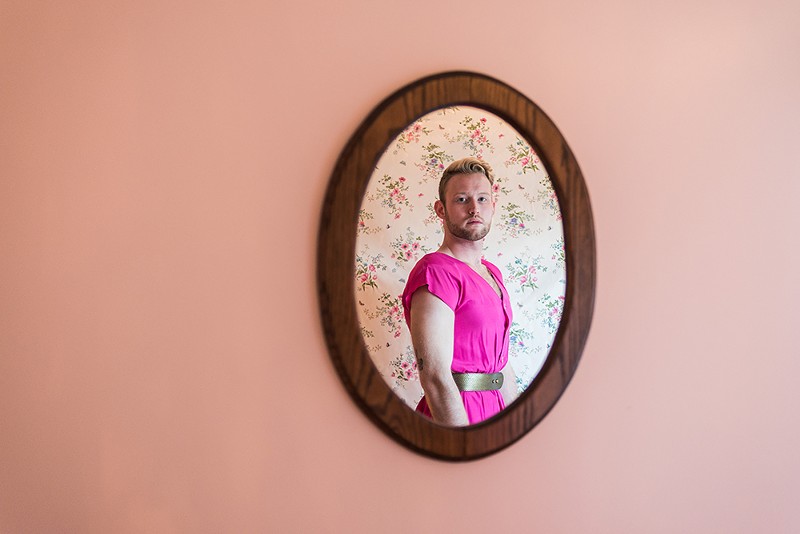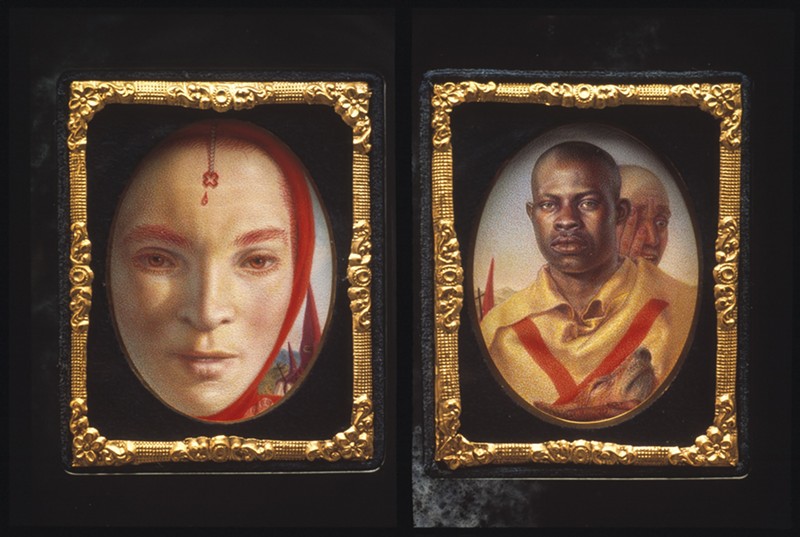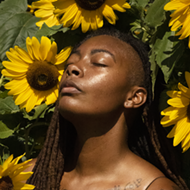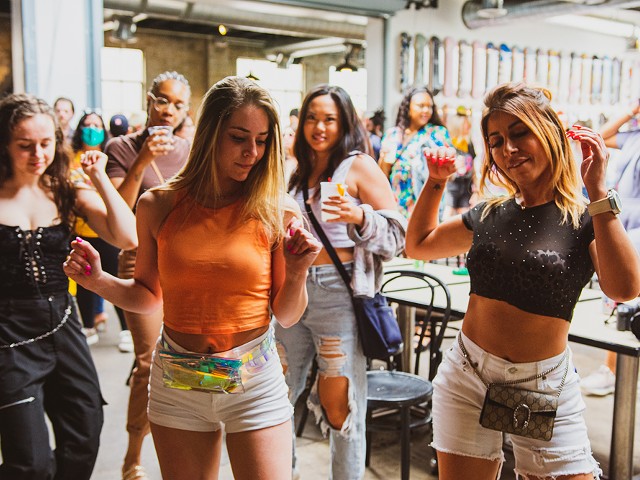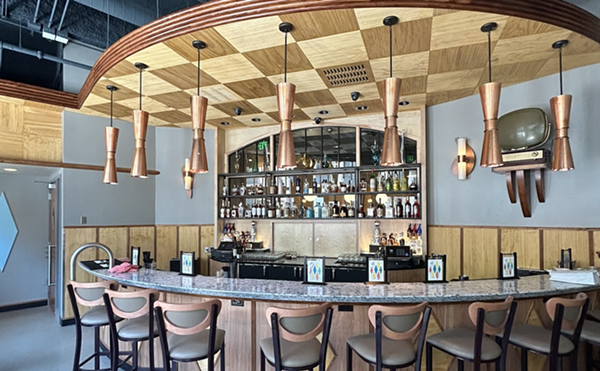Despite the narrative some conservatives and uninformed clowns try to push, being LGBTQ is not a "liberal trend" that just emerged within the last decade. Queer people have always been a part of society, making integral contributions to art and culture, especially here in Detroit.
Take LeRoy Foster, for example, a gay Detroit painter who performed under the drag persona Martini Marti back in 1945. Foster painted several historic murals for the city including "The Life & Times of Frederick Douglass" at the Detroit Public Library Douglass Branch, and "Renaissance City" at the original Cass Tech depicting the city's rise from the ashes of the 1967 rebellion.
He was a longtime friend to prominent Detroiters like Charles McGee and Charles H. Wright, even painting a portrait of the latter (which the Charles H. Wright Museum reportedly still has). Yet most Detroiters have probably never heard LeRoy Foster's name.
That will change during Mighty Real/Queer Detroit, a month-long exhibit in June highlighting the work of more than 150 queer Detroit artists. Paintings, photography, and drawings from 1945 all the way to 2022 will be spread across 17 galleries, celebrating 77 years of queer art in Detroit. It's the first event of its kind, and Foster is one of the artists being honored this year.
Mighty Real/Queer Detroit may just be the biggest exhibition of queer art in the world to date, according to organizer and curator Patrick Burton.
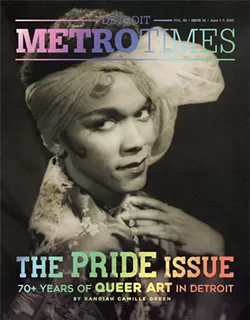
"And it's not happening in New York, or Chicago, it's happening here in Detroit," he emphasizes. "We wanted to use Pride month to present a cultural perspective because usually pride is about parades and parties. We wanted to really fill a void and highlight the artistic community. For many years queer art has been overlooked or underrepresented in art spaces."
The exhibit will have more than 700 works, including poetry and performance art, and a lineup of special events planned for the month. It sounds like a lot (and it is), but you have a whole month to see it all. It opens across Friday, June 3-Sunday, June 5. After that, the art will be up for the duration of June. Burton hopes to host the show every two years.
Participating galleries are Cass Cafe, Galerie Camille, Detroit Artists Market, M Contemporary Art, N'Namdi Center for Contemporary Art, Playground Detroit, Norwest Gallery of Art, the Scarab Club, Hatch Art, Affirmations, Anton Art Center, Collected Detroit, the College for Creative Studies, David Klein Gallery, Public Pool, Oloman Cafe+Gallery, and the Metropolitan Museum of Design Detroit.
Each gallery in the city-wide show tells its own story with a theme that unites the work on display.
"I, Too, Am America" is the concept at the N'Namdi Center, for example, which is taken from Langston Hughes' poetry book of the same name. The art here reflects on not only being Black and queer, but on speaking up and having a voice.
Initially, MR/QD was supposed to be a smaller-scale show in 2020, but it got pushed back to 2021, and then again to 2022 due to the coronavirus pandemic. In a way, the double delay was like a blessing in disguise, as interest in the show grew over time. Back in 2020, Burton planned on the exhibit being held across three galleries, but more kept reaching out to him to be involved.
"It just kept expanding and growing in size and scope, I think, because of the real need for something like this," he says. "More galleries wanted to get in on this, then Rochelle Riley (from the city's Arts and Culture department) got involved and wanted us to get even more artists. In the summer of 2021 we were maybe at 10 galleries, and now we have 17 spaces. This is really a grassroots project, and that we were able to bring together this many artists shows how enthusiastic people are to work on this."
Burton, who grew up frequenting queer Detroit discotheques in the '70s, curated the exhibit to highlight both established and emerging artists, as well as those whose careers were cut short by HIV/AIDS.
To explore the history of LGBTQ+ art in Detroit, you have to start with LeRoy Foster.
"LeRoy's self portrait of Martini Marti, his drag persona from 1945, is really the start of LGBTQ art in Detroit," Burton says. "It's quite a brave piece for its time. I can't imagine in 1945 being Black, being queer, and doing drag."
Foster's black-and-white self-portrait, along with several of his paintings and drawings from the 1950s and 1960s, will be displayed in the show. His grandiose painting style draws parallels to the Italian Renaissance.
While Foster was painting and performing drag in the '50s and '60s, Stephanie Crawford was coming into her own as a jazz singer and visual artist. In 1968, Crawford underwent a "new (at the time) male to female gender reassignment surgery" being offered by the University of Michigan. Prior to that, she was working the assembly line at Chrysler.
Since then, Crawford has lived her life authentically without fear as she performs across the globe. Beyond her hometown of Detroit, she has lived and worked in Paris, New York, and California, where she now lives. She was even awarded the Django D'Or Award for Best International Jazz Vocalist in 1993. Yes, a trans woman from Detroit did that.
Though world-renowned for her vocals, Crawford continues to paint into her eighties. Her first-ever solo exhibit, in 2020, even got a shout from the New York Times. Though her still-life paintings of flowers seem simple, Crawford's creative process is driven by the complexity of working with watercolor, her medium of choice.
"You can't control it, you can try, but watercolor does what it wants," she says in an artist statement. "In most mediums, paint stays where you put it. Watercolor complies with gravity and parallels the improvisation of jazz."
Here are a few other featured artists look to watch out for during Mighty Real/Queer Detroit:
Julie Sabit
At 90 years old, Julie Sabit is the oldest living artist in the Mighty Real/Queer Detroit exhibit. The show is sort of a coming out for Sabit, who was born and raised in the Motor City.
Sabit tells Metro Times though she never lied when people asked about her sexuality, and many probably assumed she was gay, this exhibit is the first time she's openly broadcasting it to the world.
"I don't expect that I'm shocking anybody when I tell them I'm in this big queer show, but it is the first time I'm admitting to everyone I'm gay, and just saying it out loud, so, in fact, it is a coming out," she says. "I don't particularly see gayness in my paintings, to be honest. I just love to paint people doing things."
Sabit finds excitement in painting people doing leisurely activities like sitting down, reading books, and simply existing. Detailed paintings in muted colors make the viewer pay attention to the seemingly mundane moments of human life. They hone in on the "unposed gestures" of how people relate to each other.
One of Sabit's most profound memories of being queer in Detroit is when her application to Wayne State's College of Education was denied because she was gay back in 1950.
"They were purging suspected gays from the College of Education, so it stopped my registration," she says. "I had to register in the Liberal Arts College in sociology because I was a suspected gay person. I talked to a counselor they had there about my gayness and I ended up just saying, 'OK, I'm going to bed with a man now.' I guess they considered gay people as 'groomers.'"
Other than the "1950 purge," as she calls it, Sabit says she isn't aware of being treated any differently for being queer.
While things are much different at Wayne State these days, some things never seem to change. Sabit's painting "CHOICE" depicts an abortion rights rally that she attended in Washington, D.C., back in 2004. Though the piece was completed in 2005, it's become relevant once again as the U.S. Supreme Court mulls over reversing Roe v. Wade and sending us all back to the 1920s.
"We want to call ourselves the leaders of the free world, and we're going to force victims of rape and incest to carry babies? Sheesh," she says about the current fight around abortion rights and Michigan's antiquated reproductive laws. "It's ridiculous."
"CHOICE" will be on display at the Anton Art Center; 125 Macomb Pl., Mount Clemens. theartcenter.org. You can also see Sabit's work at Galerie Camille, Collected Detroit, Anton Art Center, and Hatch Art.
“I like celebrating joy because I’ve experienced so much pain, so I cling to the joy.”
tweet this
Mieyoshi Ragernoir
While Sabit represents old-school queer artists in Detroit, Mieyoshi Ragernoir is ushering in the new school. The recent Cranbrook Academy of Art graduate celebrates the radiance of Black pride, joy, and community in her paintings.
You'd have to be a serious grinch for Ragernoir's art to not make you smile. The bright colors all but pop off the canvas, and the subjects are smiling, laughing, and living their best life — an invitation for viewers to do the same.
"I like celebrating joy because I've experienced so much pain, so I cling to the joy," she says. "My celebratory style started in 2020. A lot of my work was based on trauma and healing prior to that, so there weren't so many smiles in it. Once I graduated [from] undergrad in 2020, it was like I spent all these years in pain, I couldn't look at another sad or stoic face. And, a lot of police violence was happening in New York City at the time, so I just needed the smiles."
Ragernoir was born in Harlem and grew up in the West Bronx. She moved to Michigan for graduate school at Cranbrook in 2020 and is now based in Detroit.
The trauma and pain influencing her work come from being rejected by family and the world. Ragernoir's maternal side of the family was not very accepting when she came out as "attracted to all humans," as she puts it.
"Coming from a strict, southern, Christian family, when you're a teenager and you're not dating boys at all, they're like, 'What's going on?,'" she says. "I came into my own when I turned 19 and was reading books about meditation and gratitude. When you're focused on gratitude and self-healing, it's hard to be anything other than authentic. But to my family, I wasn't out until I was 21."
One of Ragernoir's paintings in MR/QD is "Joyride," which shows three stylish friends riding in the backseat of a taxi as a rainbow and all-seeing eyes watch over them. It was inspired by a car ride with her friends on their way back to Cranbrook after getting Caribbean takeout.
"All of us were riding in the backseat and the energy was just so good. We were so excited," she says. "I know life is always in the present, so I hone in on those happy moments. When I'm smiling and happy, I really simmer on it and it comes back out into my artwork."
"Joyride" will be on display at Norwest Gallery of Art; 19556 Grand River Ave., Detroit; norwestgallery.com. You can also see Ragernoir's work at Norwest Gallery of Art, N'Namdi Center for Contemporary Art, Playground Detroit, Galerie Camille, Cass Cafe, and the Anton Arts Center.
Bakpak Durden
Bakpak Durden has been doing the damn thing in Detroit's art scene the past few years. They have murals around the city from BLKOUT Walls mural festival in and around the North End neighborhood to the side of the Yum Village restaurant and the Eastern Market.
The attention to detail expressed in Durden's work is hard to match. It's even more fascinating when you consider that Durden is self-taught, which is hard to believe given the painstaking mastery exhibited across their portfolio.
Their painting "Self Portrait: Photographic Memory" reflects the tendency of human nature to hold onto fleeting moments and cling to memories that may or may not be good for us. But at the same time, we must remember those depressing and sad moments in life, lest we repeat them in an endless cycle.
"It's holding onto something after it's ended, but in the midst of depression and anxiety, I feel like there's this amnesia that happens and you end up repeating the same things," Durden says. "I kept putting myself in some not great situations and thinking, 'How did I get here again?' You're doomed to repeat your worst mistakes if you don't remember how you got there."
Burton calls Durden a modern-day LeRoy Foster, someone who is before their time in both their work and unapologetically owning their identity. The audacity to be your one hundred percent authentic self is a beautiful thing.
Though their work is heavily influenced by their trans identity, Durden wants exhibit goers to know there is something for everyone.
"The whole point of most all of my work is that the viewer gets to put themselves in the place of the narrator," they tell Metro Times. "Trans identity influences all of my work because my perspective is one of trans experience, especially as someone who is on this vast gender spectrum with no bounds. There's a lot to be considered when it comes to perception and how something is going to be perceived by someone who has no context. My work is probably deeper than you think, but also not."
A lot of Durden's work centers around mental health, which is something they struggled with most of their life until recently.
"Basically my whole life I've been trying to find someone who will listen and not be quick to either prescribe medication or be paternalistic," they say. "It's been a lifelong journey to get to where I could advocate for myself and have better means to get the mental health services that I require and desire... I like to think that I'm still growing up queer in Detroit and now I'm more aware and have access to language to describe who I am and how I'm feeling. In my younger years, I didn't feel like that was always the case."
Durden says above all else, they want to acknowledge Detroit's pivotal role in all facets of culture, especially Black queer artists in Detroit who are moving culture forward.
"That's just what we do," they say. "We're special."
"Self Portrait: Photographic Memory" will be on display at Playground Detroit; 2845 Gratiot Ave., Detroit; playgrounddetroit.com. You can also see Durden's work at Norwest Gallery of Art, Detroit Artists Market, M Contemporary Art, and Playground Detroit.
Brian Kovach
Brian Kovach may not be a native Detroiter, but Detroit's LGBTQ community is the only one he's known. Kovach grew up in Akron, Ohio, and moved to Michigan to attend Cranbrook for graduate school, like Ragernoir. He graduated from Cranbrook in 2021 and is now based in Birmingham.
"Being in [metro] Detroit was the first time I was able to have discussions about queerness and have people talk about my work from a more educated perspective," he says. "The open-mindedness of the LGBTQ community here that I've experienced is pretty great. It's helped me a lot, being able to talk things through with people that have had similar situations. And Detroit has this crazy cool art community with so many people who are super understanding as well."
Kovah is a photographer who also makes mixed-media collages. His art explores breaking the perceived molds that define masculinity, and several of his photos feature him wearing his mother's clothing. One such piece that stands out is "My Mothers Closet."
"My mom kept everything from probably the 1970s until now, so I started putting myself in the clothes that I remember her wearing when I was growing up," he says. "When I was growing up, a lot of these ideas of masculinity that 'you have to act like a boy' were actually my mom's teachings. She would never say that directly, but sometimes it felt like the more feminine I acted, the more disappointed my family was."
Kovah recalls coming out to his family and being struck by how simply being gay somehow made him a different person.
"How did I become a stranger when I've been here the whole time," he says. "I've never not been myself, so the fact of me literally just coming out of the closet being a deterrent was strange to me. I was doing manual labor at the time and when they found out I was gay, I was suddenly no longer getting jobs... It was this idea of trying to get them to understand that I'm still the same kid, regardless of whether I go get my nails done or put on feminine clothing."
His work is like a timeline of his life that aims to show queerness is more than just "a pocket like some people think it is."
"Whether it's dealing with sex, gender, or intimacy in general, my work really comes from a perspective of love for humanity," he says. "It's me trying to encapsulate my experience as a human that also fits into this idea of queerness as a whole community. The art will speak for itself. In this exhibit, we have art all the way back from the '50s so we will see whether things have changed that much. I'm excited to experience it as a whole and also incredibly grateful to be involved."
"My Mothers Closet" will be on display at M Contemporary Art; 205 E. Nine Mile Rd., Ferndale. mcontemporaryart.com. You can see Kovach's work at M Contemporary Art and Norwest Gallery of Art.
Mighty Real/Queer Detroit events
MR/QD Artists’ Reception and celebration with DJ Kai Alcé
8 p.m. to 10 p.m. reception; 10 p.m. to 2 a.m. celebration on Thursday, June 2 at Menjo’s, 950 W. McNichols Rd., #928, Detroit; menjoscomplexdetroit.com.
MR/QD Opening Weekend
From 5-9 p.m on Friday, June 3 at Cass Cafe, College for Creative Studies, Detroit Artists Market, Galerie Camille, N’Namdi Center for Contemporary Art, Playground Detroit, and Scarab Club.
From 5 p.m. to 9 p.m. on Saturday, June 4 at Affirmations, Hatch Art, M Contemporary Art, Norwest Gallery, Oloman Cafe, Public Pool, Anton Art Center (2 p.m. to 4 p.m.), and the David Klein Gallery - Birmingham (2 p.m. to 7 p.m.). From 2-6 p.m. on Sunday, June 5 at Collected Detroit, and the Metropolitan Museum of Design Detroit.
Stephanie Crawford Artist Talk
7 p.m. on Tuesday, June 7 at the Scarab Club, 217 Farnsworth St., Detroit; scarabclub.org.
Performance art by Vagner Whitehead
3 p.m. on Saturday, June 11 at Detroit Artists Market, 4719 Woodward Ave., Detroit; detroitartistsmarket.org.
Poetry, performance art, and music featuring Cherry Wood, Meg Foley, Stephanie Glazier, and Jess Julien
6-8 p.m. on Wednesday, June 15 at Galerie Camille, 4130 Cass Ave. suite C, Detroit; galeriecamille.com.
Juneteenth poetry reading with Tommy Blount, Deidre D.S.Sense Smith, Lester Rambus, and Mars Marhall
6 p.m. on Wednesdsay, June 22 at The Scarab Club, 217 Farnsworth St., Detroit; scarabclub.org.
Trade Center film panel discussion with Billy Miller and Tim Retzloff
4 p.m. on Saturday, June 25 at N’Namdi Center for Contemporary Art, 52 E. Forest Ave., Detroit; nnamdicenter.org.
Queer short films
7 p.m. on Tuesday, June 28 and Wednesday, June 29 at Cinema Detroit, 4126 3rd Ave., Detroit; cinemadetroit.org.
Hatch Art artists talk
2 p.m. on Sat, June 25 at Hatch Art, 3456 Evaline St., Hamtramck; hatchart.org.
For more information including the full lineup of artists, see mrqd.org. The College for Creative Studies will provide free parking and shuttle bus.
Stay connected with Detroit Metro Times. Subscribe to our newsletters, and follow us on Google News, Apple News, Twitter, Facebook, Instagram, Reddit, or TikTok.

